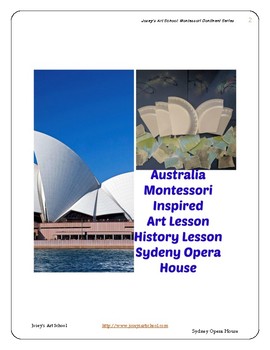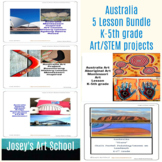Australia Sydney Opera House History Art Montessori Pre-K to 4th Common Core
- PDF
Also included in
- Attention Montessori and Elementary Teachers! Are you looking for a fun and engaging way to teach your students about Australia? Look no further than our Australia Theme 5 Art STEM Lessons Bundle, which includes easy-to-follow geography projects and stand-alone art lessons.Our bundle includes five uPrice $11.99Original Price $15.95Save $3.96
Description
Are you looking for an exciting and educational lesson that will teach your students about one of Australia's most iconic landmarks, the Sydney Opera House? Look no further! Our paper plate Sydney Opera House lesson is perfect for all ages and skill levels.
In this lesson, your students will learn about the history and significance of the Sydney Opera House, its unique architecture, and the culture of Australia. They will also get to create their own version of the Opera House using simple materials such as paper plates, scissors, and markers.
With easy-to-follow instructions, this lesson is perfect for classroom activities or at-home learning. Your students will love using their creativity and imagination to design and construct their very own Sydney Opera House.
Not only is this lesson fun and engaging, but it also promotes critical thinking, problem-solving, and cultural awareness. It's a great way to incorporate art and social studies into your classroom curriculum.
So why not take your students on a virtual trip to Australia and teach them about the iconic Sydney Opera House? Order our paper plate Sydney Opera House lesson today and watch your students' creativity and knowledge grow!
THIS LESSON COMPLIES WITH MANY ELA COMMON CORE STANDARDS
Continent: Australia
Art Project: Sydney Opera House
History Lesson about the topic
Perfect for a continent lesson extension in Montessori Pre-K classroom
-Copy of the real life pictures
-Discussion about the topic and real life pictures to engage with the students in deeper conversation
-questions to ask your students to engage the pictures
-opportunity to write about the experience
CLICK HERE to view my freebies
CLICK HERE to view my DRAWING LESSONS
CLICK HERE to view my ART WITH THE MASTERS ART LESSONS
CLICK HERE to view my CONTEMPORARY ART LESSONS
CLICK HERE to view my ART LESSONS THAT COMPLIMENT POPULAR BOOKS
CLICK HERE to view my SELF ESTEEM PROJECTS
CLICK HERE to view my CLASS MURAL IDEAS
CLICK HERE to view my FUN ART FOLK ART LESSONS
CLICK HERE to view my 3 BUNDLED LESSONS
CLICK HERE to view my 5 BUNDLED LESSONS
Make sure to click the GREEN STAR near my store name so that you can stay in touch with my store. I create new lessons every week.






